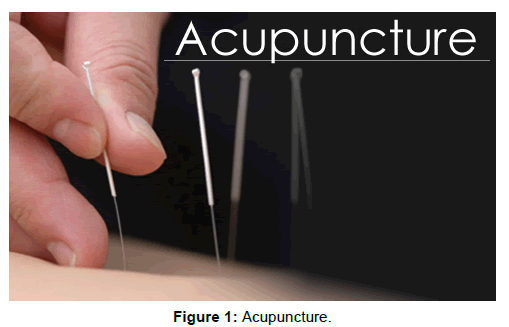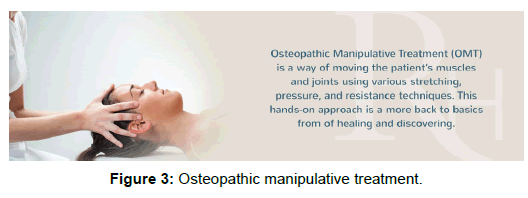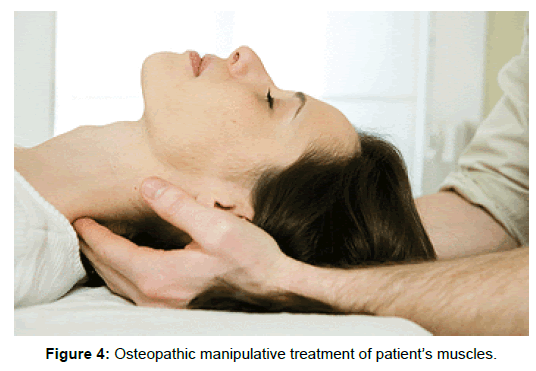Utilizing Acupuncture and Osteopathic Manipulative Treatment (OMT) in the Integrative Treatment of TMDs
Received: 08-Feb-2017 / Accepted Date: 15-Feb-2017 / Published Date: 22-Feb-2017 DOI: 10.4172/2161-119X.1000292
254600Introduction
Integrative medicine is the conscientious and purposeful integration of complimentary and conventional approaches to medicine (especially pain management), in a coordinated way. Medicine’s leading accreditor, the Joint Commission, issued a “clarification standard” for pain treatment that significantly elevates numerous nonpharmacologic approaches. The Joint Commission stated that, among others, acupuncture and osteopathic manipulative treatment (OMT) were valuable [1].
Acupuncture is a method of treating disease by stimulating certain points or loci on the body (developed over 3,000 years ago). Since 1949, there have been great advances in the techniques and materials utilized in acupuncture treatment, based upon the traditional foundations of energy channels and points, as well as principles of modern medicine. New forms of stimulation, including electrical and laser are now utilized [2].
Osteopathic Manipulative Treatment (OMT) is a soft tissue handson approach applied to areas of somatic dysfunction in a patient to help restore motion and improve function. One modality of OMT, referred to as Osteopathic Practices in the Cranial Field or Cranial Manipulation, involves treatment of the head, face, and upper cervical spine by applying gentle manual forces to address somatic dysfunction, subsequently affecting the patient through benefits to the Primary Respiratory Mechanism (PRM) [3].
The Primary Respiratory Mechanism, first described by William Sutherland, DO, manifests as a palpable motion of the cranium. This occurs as a result of an inherent central nervous system motion which is transmitted to the cranial bones through the dural membranous attachments to each structure. This slight motion results in a fluctuation of cerebrospinal fluid in the subarachnoid space. The PRM is synchronous with the cranial rhythmic impulse, a 2-phase rhythmic cycle throughout the body that represents a dynamic metabolic interchange with each phase of action [4].
Temporomandibular disorder (TMD) is clinically characterized by pain in the masticatory muscles of the temporomandibular joint (TMJ). It affects an estimated ten million Americans and 1/3 of adults experience symptoms of TMD over their lifespan [5]. Clinically, patients complain of pain, tenderness, headaches, restricted jaw movement, muscle stiffness, and weakness of the masticatory muscles [6].
Current medical/dental interventions for the management of TMD consist of jaw appliance therapy (stabilization splint or bite-guard), medication, physiotherapy, home self-care and surgery. Acupuncture may be used as a stand-alone treatment or as part of an integrative treatment plan for the management of TMD.
Additionally, Self-Care Strategies for the management of TMD include:
• Eating soft foods;
• Applying ice-packs;
• Avoiding extreme jaw movements;
• Relaxation and stress reducing techniques; and
• Gentle jaw stretching and muscle relaxation exercises.
Both Integrative and Interdisciplinary management of TMD pain are now the best methods to manage both acute and chronic pain. While interdisciplinary (Interprofessional Education and Collaboration— IPE/IPC) pain management involves multiple specialists utilizing a team-based approach; integrative care includes alternative and complimentary methods that augment traditional pain management with pharmaceuticals [7].
While this approach should be the dominant approach in pain management, it is neither being taught or utilized in the curriculum of many medical and dental schools. Physicians and dentists should embrace the contributions of other health professionals; and, function as a team, especially in the treatment of pain.
Acupuncture
Although the exact mechanism by which acupuncture may relieve TMD pain is not entirely understood, according to ancient theories of Traditional Chinese Medicine (TCM), acupuncture acts by restoring the balanced flow of “Qi”, or energy. In fact, research suggests that acupuncture may suppress the nociceptive Trigeminal Nucleus Caudalis and Spinal Dorsal Horn neurons via modulation of the release of neuropeptides and neurotransmitters (Figure 1).
The contraindications to using acupuncture are:
• Patients receiving anti-coagulation therapy;
• Electro-acupuncture should be avoided in patients with pacemakers; and
• There is a risk of miscarriage when utilizing acupuncture during the first trimester of pregnancy, and premature labor in the final two [2] months if improper points are needled.
Common-sense guidelines for acupuncture include:
• If discomfort from acupuncture needle insertion persists, move the needle;
• Patients who are unable to remain still for the duration of the treatment are not suitable for acupuncture treatment; and
• Acupuncture treatment should not be used if there is any indication of possible infection at the site being considered for needle insertion.
Overall, acupuncture offers a useful treatment modality in the management of TMDs. It is simple, relatively safe and efficacious, and a useful technique in the integrative treatment and management of TMD (Figure 2).
Osteopathic Manipulative Treatment (OMT)
Osteopathic Manipulative Treatment involves gentle application of manual forces applied to muscles, ligaments, joints, and fascia. There are several osteopathic treatment modalities that differ in how forces are applied to the tissue and the resultant effect to those tissues. Generally, OMT will either directly stretch soft tissue or mobilize restricted joints, or will relax soft tissue to allow a release of tension or restriction. These tissue changes allow proprioceptive and neuromuscular tissue changes, which allow normal resilience and homeostasis to be restored. The osteopathic modalities applied to the cranium utilize gentle application of manual forces and inherent tissue motion to affect the primary respiratory mechanism, and stimulate a patient’s own innate healing response. In TMD, the osteopathic treatment is usually focused on restricted muscles of mastication, or imbalances found in ligaments such as the Temporomandibular or Sphenomandibular ligaments (Figures 3 and 4).
One specific cranial technique known as the “Compression of the Fourth Ventricle (CV-4)” is profoundly relaxing, enhances cranial rhythmic function, and improves lymphatic flow [8]. Physiologic changes include enhancement of fluid movement, changes in the rhythm of the diaphragm, and increases in the temperature in the suboccipital region [9].
Osteopathic manual therapy for TMD is a viable, cost effective and reversible mode of conservative medical treatment; and OMT of the TMJ specifically, while remaining relatively untested in the scientific literature, may have much to contribute to future TMD research.
In a published study of “Osteopathic Manual Therapy versus conventional conservative therapy in the treatment of TMD: A Randomized Controlled Study”, the results showed that patients in both groups improved during the six months of treatment. However, the OMT group required significantly less medication (NSAIDS and Muscle Relaxants) [10].
While there is multiple traditional medical/dental treatments for TMDs and other pain syndromes, the incorporation of acupuncture and osteopathic manipulative treatment are beneficial as part of an integrated, interdisciplinary approach to TMD.
References
- Revisions to Pain Management Standard Effective (2015) The Joint Commission.
- O’Connor J, Bensky D (1998) Acupuncture: A comprehensive text. Eastland Press, Seattle.
- Jäkel A, von Hauenschild P (2011) Therapeutic effects of cranial osteopathic manipulative medicine: A systematic review. J Am Osteopath Assoc 111: 685-693.
- King HH, Lay E (2003) Osteopathy in the cranial field. In: Ward RC (eds.) Foundations of osteopathic medicine. Lippincott Williams and Wilkins, Baltimore, pp: 985-1001.
- Okeson J (2004) Bell’s orofacial pains: The clinical management of orofacial pain. Quintessence Publishing Co. Eur J Orthod 27: 532.
- Greene CS, Laskin DM (2012) Treatment of TMDs: Bridging the gap between advances in research and clinical patient management. Quintessence Publishing.
- Malone MA, Gloyer K (2013) Complementary and alternative treatments in sports medicine. Prim Care 28: 155-156.
- Chaitow L (1999) Cranial manipulation theory and practice: Osseous and soft tissue approaches. Elseviar Churchill Livingstone, Edinburgh.
- Ettlinger H, Gintis B (1991) Craniosacral concepts. In: DiGiovanni E, Schiowitz S (eds.) An osteopathic approach to diagnosis and treatment. Lippincott Co., Philadelphia J.B.
- Cuccia AM, Caradonna C, Annunziata V, Caradonna D (2010) Osteopathic manual therapy verses conventional conservative treatment of TMD: A randomized controlled study. J Bodyw Mov Ther 14: 179-184.
Citation: Goldstein LB, Shoup D, Troncoso V (2017) Utilizing Acupuncture and Osteopathic Manipulative Treatment (OMT) in the Integrative Treatment of TMDs. Otolaryngol (Sunnyvale) 7:292. DOI: 10.4172/2161-119X.1000292
Copyright: © 2017 Goldstein LB, et al. This is an open-access article distributed under the terms of the Creative Commons Attribution License, which permits unrestricted use, distribution, and reproduction in any medium, provided the original author and source are credited.
Select your language of interest to view the total content in your interested language
Share This Article
Recommended Journals
Open Access Journals
Article Tools
Article Usage
- Total views: 7433
- [From(publication date): 0-2017 - Aug 23, 2025]
- Breakdown by view type
- HTML page views: 6522
- PDF downloads: 911




